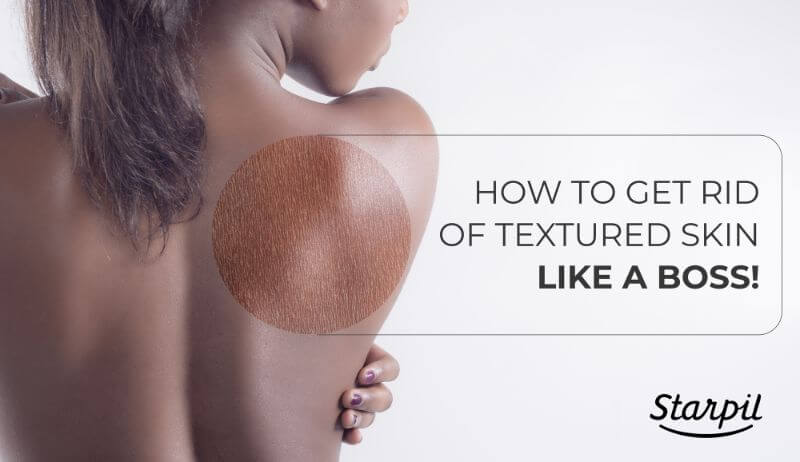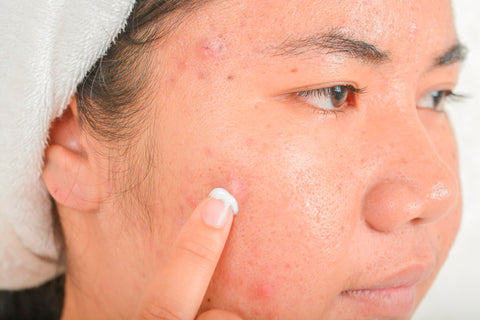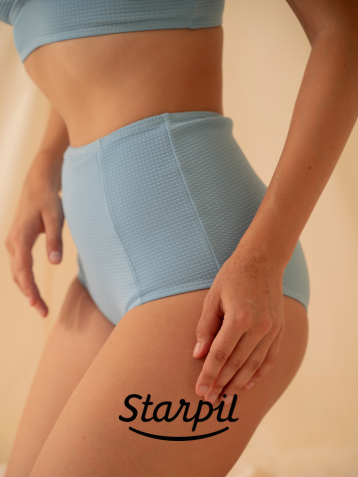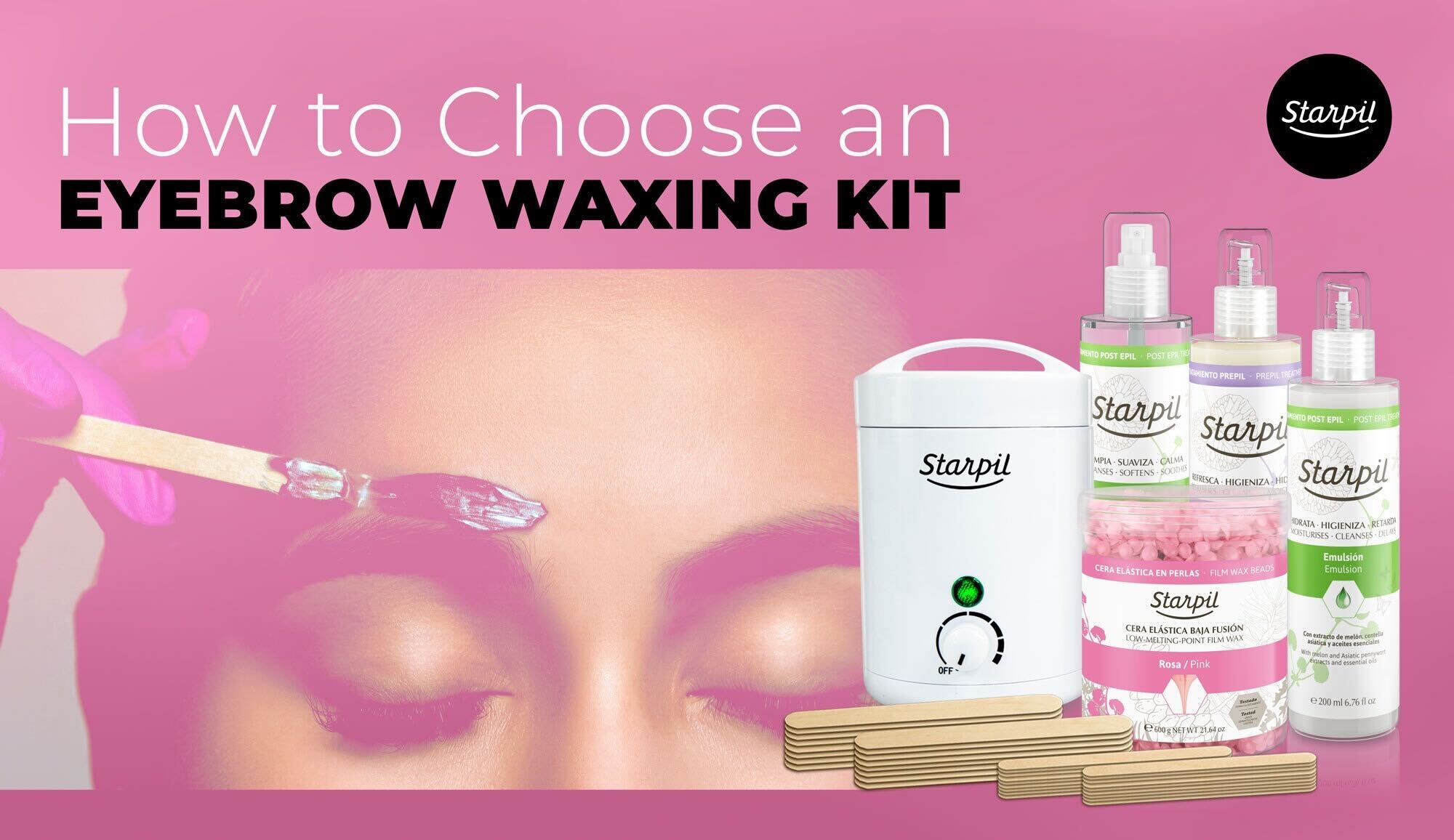How to Get Rid of Textured Skin - The Ultimate Guide


There’s no doubt that most of us want to have smooth, soft skin that both looks and feels its best. Whether or not you experience blemishes or textured skin, there always seems to be something in the way of having consistently smooth skin. From acne to fine lines and wrinkles, and even those random bumps that just appear seemingly out of nowhere - it seems like anything can pop up to ruin your skin’s day!
Table of Contents
With so many different issues that can contribute to textured skin, where do you even start on the path to treatment? Well, if your skin texture is anything but smooth as silk, we have some info for you.
In this blog, we’ll discuss “What is skin texture?”, how to care for each skin type, and how waxing textured skin should be done to retain the integrity of your skin and aid in smoothing unevenness. We’ll also dive deep into the causes and solutions for body and face texture according to skin type.
READ: How to Get Smooth Skin That Lasts
What is Textured Skin?
Skin texture, or ‘textured skin’, is an overarching term that describes the condition of the skin's surface.
Healthy skin texture feels supple, soft, and smooth, and is plump. This indicates an ample balance of hydration, sebum, collagen, and elastin (the building blocks of healthy skin).
Uneven skin texture can be rife with dry skin patches or oily skin patches. It can involve skin tags, ‘chicken skin’, or can have the appearance of bumpy skin texture or acne, milia, or pustules. Skin’s surface can feel thick and rough and appear dull, and blotchy with discoloration and hyperpigmentation.
READ: Working with Different Skin Types
What are Different Skin Texture Types?
Many different skin texture types stem from various internal and external issues.
From dehydrated skin texture, which includes dry patches and a sandy skin texture, to oily skin texture issues like acne, orange peel skin texture, and acne scarring, everybody experiences symptoms differently.
Dry or Dehydrated Skin Texture

Dry skin usually refers to a skin type that lacks the ability to retain water or produce adequate oils.
Dehydrated skin, on the other hand, loses water moisture through external circumstances like the weather, an imbalance of lifestyle choices, or a lack of skincare support. That being said, dehydrated skin isn’t only limited to dry skin types. Oily skin can also be dehydrated, but differentiating between the two can be difficult. Luckily for you, we've broken it all down!
When skin lacks its ability to retain water, it can develop a rough skin texture that includes the following issues:
- Dry patches
- Hard bumps
- Snake skin texture
- Flaking
- Peeling and redness
- Tight and itchy
- Slits, cracks, and fissures
- Sandy skin texture
- Fine lines and deep wrinkles
- Sagging due to elasticity loss
- Skin has a dull complexion and “dusty” finish
LEARN MORE: Waxing and Dry Skin
Oily Skin Texture Issues

As previously mentioned, oily skin texture issues can often result from what’s actually dehydrated skin.
Because they don’t recognize the symptoms of having both dehydrated and oily skin, many with genetically oily skin might forgo hydrating skincare support. They also might use harsh skincare products that strip the skin without balancing out their routine with moisturizers, since they think their skin will only get worse from it. This unfortunately will only exacerbate existing issues.
Oily skin can be genetic or enhanced through hormonal changes or imbalanced lifestyle choices. The following skin texture issues may occur with oily skin:
- Large pores or orange peel skin texture
- Acne textured skin
- Flaking underneath oil
- Elasticity loss and sagging
- Continuous shine
- Acne, pustules, blackheads
- Acne scarring
- Bumpy skin texture
- Clogged pores

Uneven Skin Texture vs. An Uneven Complexion
Aside from skin texture issues that you can feel, textured skin issues can also affect the complexion of the skin through hyperpigmentation, melasma, sallowness, redness, and undereye circles.
Dull skin texture is often associated with dry or oily skin that hasn’t been properly exfoliated.
READ: Working with Dry vs. Dehydrated Skin: A Guide for Professionals

What Causes Textured Skin?
For those wondering “Why is my skin so textured?”, it can come down due to a variety of factors in addition to your unique skin type predispositions.
Some skin texture issues stem from genetics, medications, hormonal changes, or allergies, while others are caused directly by an imbalanced lifestyle, diet, a lack of stress management, sleep, or skincare.

When wanting to know what causes textured skin, the first place to examine is our microbiome. The microbiome is a network of trillions of good bacteria found in the gut and on the skin that support the building of immunity and tissue-building cells.
It’s like an internal and external shield that protects and supports the body’s functions and shields us from autoimmune diseases and various pathogens.
When the microbiome is working overtime to protect us from the side effects of too many imbalances in our lifestyles (too much sun, sugar, alcohol, stress, or a lack of sleep, for example), it weakens its ability to protect against the three main causes of skin texture:
- Dehydration
- Inflammation
- Free radical damage
The microbiome helps the skin keep itself hydrated, in stasis (balanced from inflammation), and protected from free radical damage caused by an imbalanced lifestyle.
So how does gut health impact skin texture?
Remember that your gut health and what you put into your body and your gut health often have a direct impact on the health of your skin, and your body’s ability to bounce back from imbalances in your diet or lifestyle. Because having a flourishing microbiome is one of the keys to smooth skin, dehydration, inflammation, and free radical damage can wreak havoc on it in the following ways:
Dehydration

From eczema to flaking, redness, and itching, the effects of dry skin are majorly linked to the immune system and its health.
The immune system is impacted greatly by imbalanced microflora within the microbiome. Leaky gut, as well as food, skin, and inhaled allergens, plus environmental factors like pollutants, and climate impacts can all alter a healthy microbiome and dehydrate skin.
Inflammation

Textured skin from inflammation can include: bacterial, fungal, and viral infections (herpes, warts), bacterial imbalance (acne), as well as immunity dysfunction (psoriasis).
It can also be derived from allergies (redness, hives), gut conditions, excessive sun exposure, fissures, and cracks from dry skin. These issues can also cause the microbiome to go into an overdrive of sorts, and play a role in inflammatory skin texture issues.
Free Radical Damage

Dehydration can lead to inflammation of the skin, which in turn causes oxidative stress (free radical damage).
When we see skin texture issues like acne or eczema, it’s often a symptom of inflammation within the body. Oxidative stress can also be caused by our lifestyles and it further breaks down skin cells, leading to skin issues like pigmentation, dry patches, sagging, wrinkles, or dull skin.
When these three issues go unchecked, it’s like a never-ending cycle that contributes even further to breaking down the microbiome. In turn, this impacts the body, depletes skin health, and causes skin texture issues.
The following are just some of the biggest contenders in causing dehydration, inflammation, and oxidative stress leading to microbiome damage and textured skin:
Diet
Our diets are a massive contributor to the state of our microbiome and to our gut health in general.
When our digestive system has to overexert itself in order to break down potentially toxic food compounds that lack supportive vitamins and amino acids, it can be very damaging to the health and smoothness of skin.
Diets imbalanced with refined sugars and white flour, trans fats, and processed and fried foods, can break down the body in multiple ways, leading to a plethora of skin texture issues. This is when we need our good bacteria more than ever!
Stress
Stress, anxiety, depression, and other mental health issues contribute to how the brain communicates with the gut.
This link is known as the gut-brain axis, which is when the gut tells the brain to release healing anti-inflammatories to aid in regulating digestion.
Experiencing chronic stress can impede this communication. A breakdown in microflora can also further affect mental health and resilience to stress.
Stress can also lead to hormonal imbalances that add to depleting the microbiome and, in turn, skin protection.
In an article by the Huffington Post, author Julia Brucculieri talks to Dr. Joshua Zeichner, the director of Cosmetic and Clinical Research in dermatology at Mount Sinai Hospital in New York City where he states, “Stress is not our friend, neither for our mind nor for our skin.”
"Stress is not our friend, neither for our mind nor for our skin" Dr. Joshua Zeiner
Lack of Sleep
Sleep deprivation dulls skin’s ability to heal, develop collagen, hydrate, and function at its most basic levels.
Those who are lacking in sleep experience higher levels of inflammation, which also thereby increases the chances of outbreaks of acne, eczema, psoriasis, and skin allergies.
Lack of Skincare/Using the Wrong Skincare
Even with access to modern skin care methods made for different skin types and conditions, it’s easy to choose daily skincare routines that don’t end up supporting smooth skin, or even your skin health in general if you don’t do the proper research.
Using the wrong products, using products incorrectly, or not using skincare products at all can lead to dehydration, inflammation, and free radical damage.
Hormones
Hormonal imbalances or changes within the body can directly affect sebum production.
Pregnancy, thyroid issues, menstruation, a rise in cortisol levels due to stress, can all cause hormonal imbalances, increasing oil production and acne are all factors that can impact the balance of someone’s microbiome, which in turn directly affects skin texture.
Because the microbiome helps synthesize and regulate hormones and neurotransmitters, there can be breakdowns within the body if it’s not working at it’s best, which in turn can lead to skin texture issues.
Harsh Climate Exposure
If you are in a climate that exposes skin to high heat and humidity, you increase sweat and oil production. This in turn creates the potential for bacteria, breakouts, and bumps.
If you are in a dry heat environment, you increase your chances of skin dehydration.
Extremely cold climates can not only dry skin out, but leave it open to cracking and fissures for increased chances of inflammation.
Excessive sun exposure can lead to sunburns and UV damage which leads to skin cell breakdown, accelerated aging and pigmentation.
Allergies
From the food you eat, to the beauty products, cleaning supplies, and fabric softener you use, allergies can mess skin up and be a contributor to bumpy skin texture.
Allergens can leave the skin with rashes, swelling, redness, hives, or itchy skin. Inhaled allergens like pollen, dander, mold, dust, or pets, and can also cause symptoms such as sneezing, congestion, stomach pain, nausea, and diarrhea.
When we don’t address the body’s needs and when we ignore allergies, the resulting skin texture issues can be exacerbated—leading to increased dehydration, inflammation and free radical damage, overall damage to the microbiome, and resulting increased textured skin issues.
Genetics and Illness
Genetics are not the same as illness but like allergies, both can cause weaknesses in the variety of microflora in our microbiome and how it shows up to defend our skin.
Additionally, genetics cause predispositions that can hinder hydration, hormones, stasis, and neutralizing oxidative stress.
Waxing
We are a waxing blog, so we’d be remiss to share how hair removal affects skin texture.
Paying attention to hair growth cycles, pre, and post-wax care, and using the correct formulas for each skin type can all affect the skin’s response and recovery from waxing. When done incorrectly, skin can break out in acne, bumps, or ingrown hairs leading to skin texture.
For more information on how to wax textured skin, continue reading!
READ: How to Get Rid of Oily SkinHow to Get Rid of Textured Skin
With all of the ways one can experience skin texture, let’s talk about how to get rid of textured skin.
First, you need to understand what your skin texture is telling you. For example, if the skin texture is dry, it’s telling you that it needs hydration; if it’s experiencing acne, it’s telling you that it’s inflamed and needs a chill pill.
Once you determine what your skin texture is saying, you can trace your steps back to figure out why the skin is dehydrated or inflamed in order to change course and attempt to address texture at the source, while giving the skin extra support where needed.
A Balanced Diet and Exercise
Getting enough vitamins and minerals is make-or-break for your skin, and this often starts in the kitchen.
If you want to get rid of textured skin, balancing your diet is the first step toward healing anything. High-fiber diets filled with greens, berries, nuts and seeds, probiotics, and supplements are the backbone of the microbiome. Eating less meat and dairy can also be beneficial, especially if you have genetic sensitivities to lactose or red meat.
Other things that deplete your microbiome include trans fats, refined sugars, white flour, processed foods, hormones, alcohol, and drugs.
You also need to get your heart and body pumping beyond a Zoom call with your boss for at least 20 minutes three times a week, so exercise is important. Also, drink water!

Stress Management
Stress relief is a cornerstone of how to help textured skin. Look into secular, scientific, philosophical, and spiritual means to manage stress at all costs.
On more surface levels, pay attention to how often you have to be right, give unsolicited advice, gossip, are indignant or reactive, and be mindful of every time you experience envy, worry, unworthiness, doubt, fear, or anger. All of these can cause stress within the body.
Medications and Drugs
Sometimes we've got to take some medications to balance our health, including antibiotics. These can mess with the microbiome and skin, so it's important to know how to offset these effects without throwing off your skin.
You also have to give your skin added support when consuming things like caffeine, or when involved in recreational drinking and smoking.
Eat something green more than once a day, drink a lot of water, and avoid sugar and processed foods. Take a probiotic or drink kombucha.
Mind your skincare, and don’t skip taking off your makeup or cleansing and moisturizing - even after a night out! Be on top of your gut and skin health game, so you can balance other aspects of your lifestyle.
How to Protect Skin From Climate Exposure
Learning how to get rid of skin texture requires protection against the elements.
Wear sunscreen or layers, increase your water intake, elevate your skincare routine when experiencing excessive exposure to the sun, cold, dry or wet climates.
Sun Protection and Skincare Support
All skin types need cleansing, exfoliating, detoxification, water chemistry, oil chemistry, serums and/or moisturizers, but a lot of people forget about one of the most important things in skincare: sunscreen.
To protect your skin against the sun while taking retinoids or acne treatments, always make sure to wear a sunscreen of at least SPF20 or higher. These medications can make your skin highly sensitive to sun exposure. Additionally, flush and detox skin first, and impede dehydration and inflammation with water and nourishment next. Spot treat over blemishes if you can. To increase protection against the sun, wear hats, walk in the shade, and generally don’t overexpose yourself if you don’t have to.
Sleep
You have to find ways to get sleep. If you can't sleep at night, take 20-minute meditation naps twice a day.
Make up for lost sleep, sit in silence for five minutes where you can. Breathe in and out slowly 3-10 times.
Rest and sleep are paramount to everything in your life. If you find it difficult to sleep at night, use melatonin, stretch, practice breathwork, meditation, or listen to bedtime stories on Youtube. No matter what your strategy may be, sleep is one of the most important things you can do in terms of not only taking care of your skin, but taking care of yourself.
Allergies, Hormones, and Illness
The best way to address skin issues caused by unknown internal factors is to see a professional and get tested for allergens, check your hormones, and get tested for any illnesses that might be impacted your skin.
If you can't get to a doctor, start by cutting out possibly problematic aspects of your lifestyle as much as possible. Look at your diet and stress levels. Go for a walk. Stretch. Vacuum and tidy up your space. Manage stress, limit your engagement with toxicity of all kinds - your skin will thank you for it!
LEARN MORE: WHAT IS A HISTAMINE REACTION AFTER WAXING?
Genetics
Diet, skincare, and balancing stress are integral to also offsetting genetic factors that come into play with our skin. Just like with getting tested for allergens or conditions, talk to your family and see if there might be a history of skin issues, genetic acne, or other aspects that will be good to know (and hence address!).
Advisory: None of this is medical advice, just wisdom. Consult your doctor with any questions.
READ: An Esthetician’s At-Home Skincare Routine
Waxing Textured Skin
When waxing textured skin, practicing a complete pre and post-wax care routine is integral to maintaining skin evenness and avoiding doing damage to the skin.
Be careful to not exercise or go to the gym for 24 hours after waxing. You should also limit caffeine consumption before waxing. This will help improve skin texture during waxing and will save your skin from irritation or inflammation.
Having a basic understanding of hair growth cycles and staying consistent with your waxing routine will also improve your skin texture.
If you have especially sensitive skin, check out Starpil’s Starsoft Pre & Post-Wax Care. This neurosensory formula is specifically designed to reduce redness, inflammation, and irritation following a wax.
Additionally, for those with breakout-prone skin, or skin vulnerable to ingrown hairs, investigate Starpil’s Calendula Pre & Post Wax Care. These products are designed to not only soothe skin and reduce redness and inflammation, but also to sanitize skin, keep it clear from bacteria, and create a barrier between it and acne and ingrowns.
Seek out the best-reviewed service providers and be sure that they’re only using the best-quality formulas for your skin type. In addition to our Starsoft and Calendula pre & post wax care products, these formulas are also produced in wax variations, including Starsoft Hard Wax Microbeads, Starsoft Roll-On Wax, Calendula Hard Wax Tablets, and Calendula Roll-On Wax.
READ: 5 Tips for How to Wax Sensitive Skin
Skincare Routines to Improve Skin Texture
Your skincare routine is a huge aspect of improving skin texture. However, skincare without living a balanced lifestyle might only be a bandage over the true cause(s) of textured skin issues.
As with any path to treatment, you have to know where the problem is stemming from so that you can meet it with multiple solutions. This involves assessing not only for your lifestyle and diet, but also how your skincare helps or hurts your textured skin.
Almost all skin types need the following:
- To be clean from impurities without stripping the acid mantle (skin’s protective layer). This includes detoxifying congestion and exfoliation.
- Skin needs to be hydrated and moisturized with both water and oil chemistry. If you are oily, your skin still needs hydration.
- Skin needs to be able to receive nutrients from digestion and topically nourished.
- Skin needs to be protected from the inside out. Hydration, nourishment, and sun protection are all essential to this.
Cleansing, Exfoliating, and Detoxifying Textured Skin
Cleansers, exfoliators, and detox masks are all necessary for smooth skin.
You need to use the right ones for your skin type and know when to use them and how often. You also need to know how to balance them out with the proper skincare afterward. Using a cleanser like Maystar Essentials Premium Makeup Remover and an exfoliator like Maystar Essentials Exfoliating Facial Scrub can help to improve your texture and give you your best-looking skin yet.
How to Remove Textured Skin From the Body with Cleansing
If you follow a multi-step skin routine involving multiple cleansers or exfoliants, the trick to cleansing your skin is that you don’t necessarily need to do every step of it every single day.
Because not all skin texture is caused by bacteria, harsh cleansing or scrubbing doesn’t have to be your cleansing MO. That could in part be why you’re experiencing dry skin texture issues in the first place.
Start with gentle dry brushing a few times a week before showering. Focus on “strategic” cleaning more and save complete cleansing for the days when you feel like you need it. You can also incorporate Maystar Essentials Energizing Body Peel into your bodily skincare routine to improve your skin texture and leave skin soft and smooth.
Save your more intense cleansing for nighttime as your creams might be more restoring and heavier to offset stronger cleansers.
In the morning, use Maystar Essentials Micellar Water and Moisturizing Face Cream after cleansing.
After a long day of wearing heavy makeup, try using an oil cleanser or makeup remover to loosen all that beat, then follow with a warm washcloth and proceed with your skincare routine.
How to Smooth Textured Skin with Exfoliating
When exfoliating, don’t try too many products at once. Start with the dry brushing and an oil massage with sesame or jojoba oil to soften the skin.
Don’t exfoliate over open wounds or active breakouts to avoid spreading bacteria.
Exfoliation for Facial Skin Texture
When looking for the right face exfoliator, you’ve probably heard that using chemical exfoliants or retinol can be best for your skin.
Retinols can do everything from removing dry skin on a textured forehead, addressing scarring on cheeks and pigmentation throughout the face to speeding up skin recovery after breakouts.
Retinol has to be used wisely. If you’re just starting, only use the lowest concentration two to three nights (night only) a week. It’s also best to mix a pea-sized bit into your moisturizer. If you’re sensitive or dry, apply your moisturizer first, then a small amount of retinol after. Do not use retinol for a minimum of a week before waxing hair removal.
Alternatively, look for exfoliants containing AHA/BHA properties, and take care not to over-exfoliate or do it too many times a week - this can inflame skin further and lead to texture issues.
"The best way to treat an acne scar is to prevent the scar from developing to being with by using early, effective treatments," Joshua Zeichner, MD, of Zeichner Dermatology in New York exaplins. "If YOU ALREAdy have scars, topical retinoids help improve texture by simulating new collagen production. Or speak your dermatologits about professional treatment like lasers or peels"
How to Smooth Skin Texture Through Hydration and Nourishment
Apply lotions and moisturizers specifically made for the parts of your body you’re experiencing skin texture on as well as your skin type, and make sure to do so while still in the shower and wet.
Don’t scrub with your towel while drying off, just dab and press. If you’ve given yourself a quick oil massage before your shower, leave it on for five to fifteen minutes before showering or bathing.
Only practice “strategic” cleaning and don’t wash off the oil. By the time you’re done patting dry, the oil will have been adequately absorbed so that you don’t feel greasy. Also, don’t do an oil massage on the day you’re getting waxed.
READ: Introducing Maystar Essentials Skincare
The Best Products for Textured Skin

Vitamin C
For nourishing, vitamin C is one of the best products for textured skin. helps to speed up the skin renewal process, which is fabulous for smoothing acne scarring, pigmentation.
It also acts as a powerful antioxidant to neutralize free radicals. Use vitamin C skincare products on the days that you skip retinol.
Hyaluronic Acid
One of our favorite products for textured skin is hyaluronic acid. This is a moisture-binding ingredient that can hold up to 1000 times its own weight in water.
It’s excellent for all skin types but you will see a noticeable difference in sandy skin texture. Hyaluronic acid is also a powerhouse for promoting collagen formation, plumping the skin, and helping to reduce fine lines and wrinkles.
READ: Why Using Pre & Post-Wax Products is a MUST!
How to Improve Skin Texture
All of your skincare is skin-protecting in a way, especially in dry climates, but here, we’re talking about SPF. Get some according to your skin type, and be mindful of any ingredients you could be sensitive or allergic to.
If you don’t wear makeup, remember to reapply throughout the day. Wear the proper protective clothing depending on the weather to help keep a smooth skin texture.
WATCH: Check out a Dermatologist’s skin-smoothing routine!
READ: Best Esthetician Services to Offer Clients
Final Thoughts
With so many avenues for textured skin to develop through and so many ways skin texture can appear, navigating your way through how to get rid of textured skin naturally, chemically, or internally can all be overwhelming.
Take your time in figuring out what works and what your body is saying. Seek medical attention if your textured skin issues are too much to take and by all means, let us know how we can help! Smoothing textured skin can be an uphill battle, but there’s no question that with hard work, it truly pays off! Start making changes to your daily routine and watch your skin flourish.
JOIN THE #STARPILFAM
- To get The Waxopolitan in your inbox, subscribe here for all the fun!
- Get all the Starpil hook-ups with Starpil Esthie Bucks for rewards on your favorite waxing products.
- Join other professional #starpilfam members in The World of Waxing, our Facebook Group. (Have your license ready).
- Follow us on Instagram @starpilwaxUSA for all of the up-to-the-minute waxing trends, Starpil news, and earn free Esthie Bucks.
- Call us at +1 305 907-0756 or text us at (786) 315-9470 from 9:30 AM - 5:30 PM EST.







